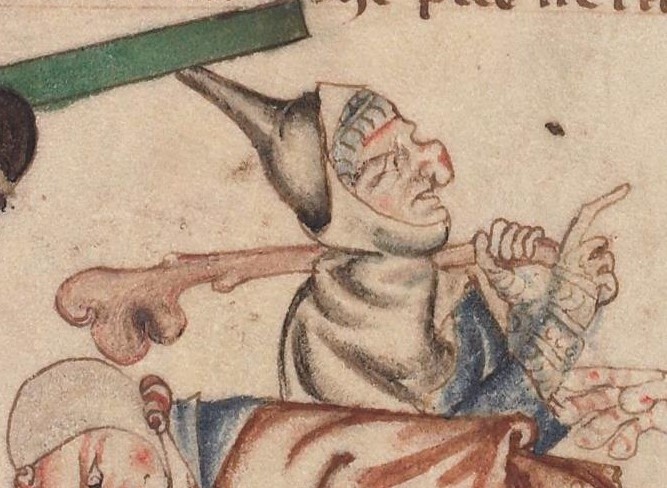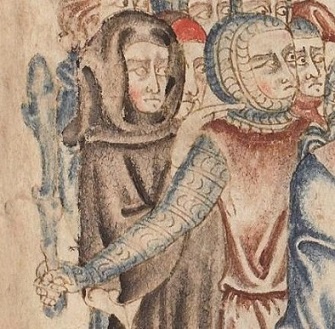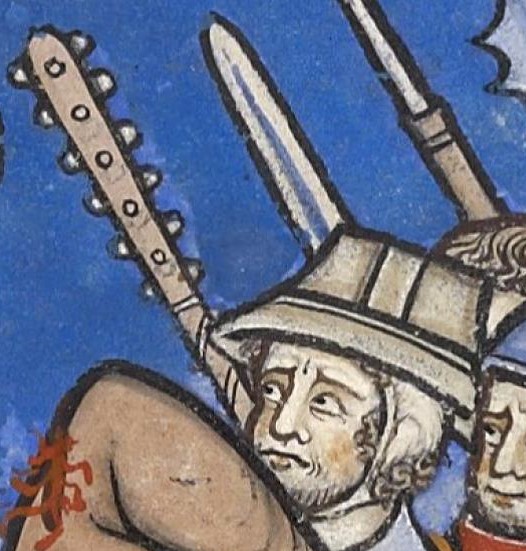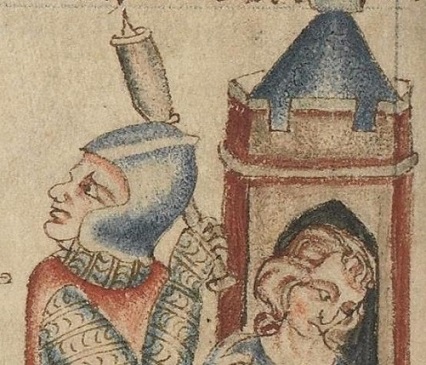I've noticed these for a while and they seem to show up century after century. Do we know anything of substance about them, or even what they were called? Are any original examples known to exist?
http://manuscriptminiatures.com/3943/10819/
http://manuscriptminiatures.com/4937/14866/
http://manuscriptminiatures.com/5001/15577/
http://manuscriptminiatures.com/3986/10903/
http://manuscriptminiatures.com/4784/12587/
http://manuscriptminiatures.com/3984/10986/
Well - I've absolutely no idea of what they were called in the time those miniatures were painted, but to me..they look very similar to what the Irish call a "Shilealgh ( sp ??) or the English call Blackthorn. I suspect it's a common item across most European peasant societies for many centuries?
Nice insight, Ralph! I'm familiar with the shillelagh but hadn't considered the similarities. If nothing else it suggests a possible means of construction.
In musters recorded in Latin, they usually show up as baculus, which can be translated as staff, stick, club, cudgel, etc.. These are quite common (along with knives, swords, and bows) among the average free man mustered in mid-14th century Norwich.
[ Linked Image ]
In Chrétien de Troyes' Yvain, the hero runs afoul of "Sons of the devil"..."And all their weapons were a pair of dogwood clubs, Made ready for war with a covering of copper and wound around with brass." (ll.5522-6)
European dogwood (cornus mas) has a specific density greater than water, i.e., the wood will not float.
http://en.wikipedia.org/wiki/Cornus_mas
| Quote: |
| Johannes de Dilham baculus gladius & cutell'.
Gilbertus Berughammaker baculus & cutell'. Stephanus Basingham gladius & cutell'. Willelmus de Drayton arcus gladius & cutell'. Bogerus Metyngham baculus gladius & cutell'. Willelmus Reed baculus & cutell'. Galiridus Bust arcus & sagitte'. |
[ Linked Image ]
In Chrétien de Troyes' Yvain, the hero runs afoul of "Sons of the devil"..."And all their weapons were a pair of dogwood clubs, Made ready for war with a covering of copper and wound around with brass." (ll.5522-6)
European dogwood (cornus mas) has a specific density greater than water, i.e., the wood will not float.
http://en.wikipedia.org/wiki/Cornus_mas
[quote= which can be translated as staff, stick, club, cudgel, etc..
[/quote][/quote]
Which sort of implies that the English for ''a club'' was ''a club''. :D
When more learned forumites stop berating me for being flippant I do have a serious question;
On the second image
http://manuscriptminiatures.com/4937/14866/
there is a sword shown with a wavy fuller for the first half of the blade and straight thereafter. Artistic licence or did such blades exist?
[/quote][/quote]
Which sort of implies that the English for ''a club'' was ''a club''. :D
When more learned forumites stop berating me for being flippant I do have a serious question;
On the second image
http://manuscriptminiatures.com/4937/14866/
there is a sword shown with a wavy fuller for the first half of the blade and straight thereafter. Artistic licence or did such blades exist?
One could argue that the image of Cain killing Abel in the Munich Golden Psalter is another early medieval example of this club: http://daten.digitale-sammlungen.de/bsb00012920/image_23. A more unambiguous example from the same psalter can be seen here: http://daten.digitale-sammlungen.de/bsb00012920/image_67.
Actually, I think clubs like this might be more common than you might expect. A club with most of the mass to one side might actually be more manageable than a club with a wide diameter head that's nearly spherical. In the same way that war axes basically never have two equally-sized axe heads on the end of a haft, a club with more weight to one size is probably easier to wield. If a club is to have all sides be equally effective for striking, a shape more akin to a baseball bat seems more advisable.
Actually, I think clubs like this might be more common than you might expect. A club with most of the mass to one side might actually be more manageable than a club with a wide diameter head that's nearly spherical. In the same way that war axes basically never have two equally-sized axe heads on the end of a haft, a club with more weight to one size is probably easier to wield. If a club is to have all sides be equally effective for striking, a shape more akin to a baseball bat seems more advisable.
As Mart said these seem to be pretty common. I wonder if more of these are not like the godendag as well. Sort of a larger category over just one simple bit of wood.
Is dogwood available here in the USA? I'd love to see that.
RPM
Is dogwood available here in the USA? I'd love to see that.
RPM
MW gives the bishop's pastoral staff as an example of a baculus, interesting here because I omitted a few David vs Goliath images that showed the former wielding the club under discussion. I've seen "kolben" in German sources but all of them have been the faceted tournament or dueling clubs like you'd see in Talhoffer or similar sources.
I agree that the asymmetric design would aid "edge alignment." They aren't altogether different than the North American gunstock and ball clubs, kind of a mix of the ball club's shape but flattened like the gunstock.
I like swords as much as the next guy but there's a lot of other neat Medieval weapons that don't get nearly as much attention, at some point I'd like to make a baculus and conduct some experiments.
I agree that the asymmetric design would aid "edge alignment." They aren't altogether different than the North American gunstock and ball clubs, kind of a mix of the ball club's shape but flattened like the gunstock.
I like swords as much as the next guy but there's a lot of other neat Medieval weapons that don't get nearly as much attention, at some point I'd like to make a baculus and conduct some experiments.
| Mike Ruhala wrote: |
| I agree that the asymmetric design would aid "edge alignment." They aren't altogether different than the North American gunstock and ball clubs, kind of a mix of the ball club's shape but flattened like the gunstock. |
Some of the Native American clubs are also made from root balls, like the English blackthorn or Irish shillelagh. Judging from the appearance of some of the examples in the Holkham Bible, knots from repeated coppicing might have been preferred. Another example is the "ragged staff" which would figure in heraldry and badges.

BL Add. MS 47682, fo.31b

BL Add. MS 47682 fo.34r
Over here in wet, slow growing England most of the thorn bushes, black, white, buck haw and holly, produce wonderful peasant clubs. Holly was used as the threshing part of grain flails btw. Its hard, knobbly and eminently wave-able.
They don't like it up 'em!
They don't like it up 'em!
| Randall Moffett wrote: |
| I wonder if more of these are not like the godendag as well. Sort of a larger category over just one simple bit of wood. |
There does seem to be that intermediate category between knobby or knotty club and mace, doesn't there? The Maciejowski Bible examples remind me of the Aztec macuahuitl, but with iron studs rather than obsidian flakes. The turned example from the Holkham Bible with some iron reinforcement seems to be of the finer sort, as well.

Morgan M.638, fo.14v

BL Additional MS 47682, fo.16v
Morgan M.638, fo.34r [ Download ]
Almost certainly variations on the basic shillelagh/knobkerrie/peasant weapon. Something that can easily be passed off as a walking stick/staff/herding tool.
As for the sword with a wavy fuller: I've seen that motif in many manuscripts. I suspect it's just an artistic convention for trying to portray a fuller in some fashion, perhaps an inlaid or inscribed fuller that would be too minuscule to paint otherwise. These are not called 'miniatures' for nothing, after all!
As for the sword with a wavy fuller: I've seen that motif in many manuscripts. I suspect it's just an artistic convention for trying to portray a fuller in some fashion, perhaps an inlaid or inscribed fuller that would be too minuscule to paint otherwise. These are not called 'miniatures' for nothing, after all!
I've seen images like that before and I'm not convinced it's meant to represent a fuller. To me it looks more like an attempt to depict a pattern welded blade.
| Mart Shearer wrote: |
| There does seem to be that intermediate category between knobby or knotty club and mace, doesn't there? The Maciejowski Bible examples |
for goodness' sake. The first rule of medieval fighting clubs is not to talk about fight club...
Ok, sorry. I'll stop making awful jokes. Maybe.
That aside, I would be far more inclined to say that the Maciejowski bible clubs bear a striking similarity to japanese Kanabo club/maces - a hardwood haft, probably studded along the length of each face with long-headed iron nails or studs, to create the knobbles.
Looks like they really can be found all over.
Some gents from a mid 14th French MS. Very well armoured as well.
http://manuscriptminiatures.com/5187/16521/
What would one use for the metal studs in these? They looks simply hammered into the wood.
RPM
Some gents from a mid 14th French MS. Very well armoured as well.
http://manuscriptminiatures.com/5187/16521/
What would one use for the metal studs in these? They looks simply hammered into the wood.
RPM
| Randall Moffett wrote: |
|
What would one use for the metal studs in these? They looks simply hammered into the wood. RPM |
If they're low social status weapons, I expect they could easily be simple wrought iron nails, no steel or heat-treatment at all. Almost hob-nail shaped, in fact.
bit like this: (first hit in google)
http://kayraplenovich.com/wp-content/uploads/2009/11/Hob-nail.jpg
There are plenty of cucifixion images showing nails with high, pointed heads.
| Randall Moffett wrote: |
| Looks like they really can be found all over.
Some gents from a mid 14th French MS. Very well armoured as well. |
And in the background among these well-armed men from the Paduan Picture Bible from c.1400, there another one.
http://www.bl.uk/manuscripts/Viewer.aspx?ref=add_ms_15277_f079r
BL Additional MS 15277, fo.79r [ Download ]
In this famous looting scene, how many bother to notice the two clubs to the far left???
http://manuscriptminiatures.com/4163/7832/
http://manuscriptminiatures.com/4163/7832/
Page 1 of 2
You cannot post new topics in this forumYou cannot reply to topics in this forum
You cannot edit your posts in this forum
You cannot delete your posts in this forum
You cannot vote in polls in this forum
You cannot attach files in this forum
You can download files in this forum
All contents © Copyright 2003-2006 myArmoury.com — All rights reserved
Discussion forums powered by phpBB © The phpBB Group
Switch to the Full-featured Version of the forum
Discussion forums powered by phpBB © The phpBB Group
Switch to the Full-featured Version of the forum